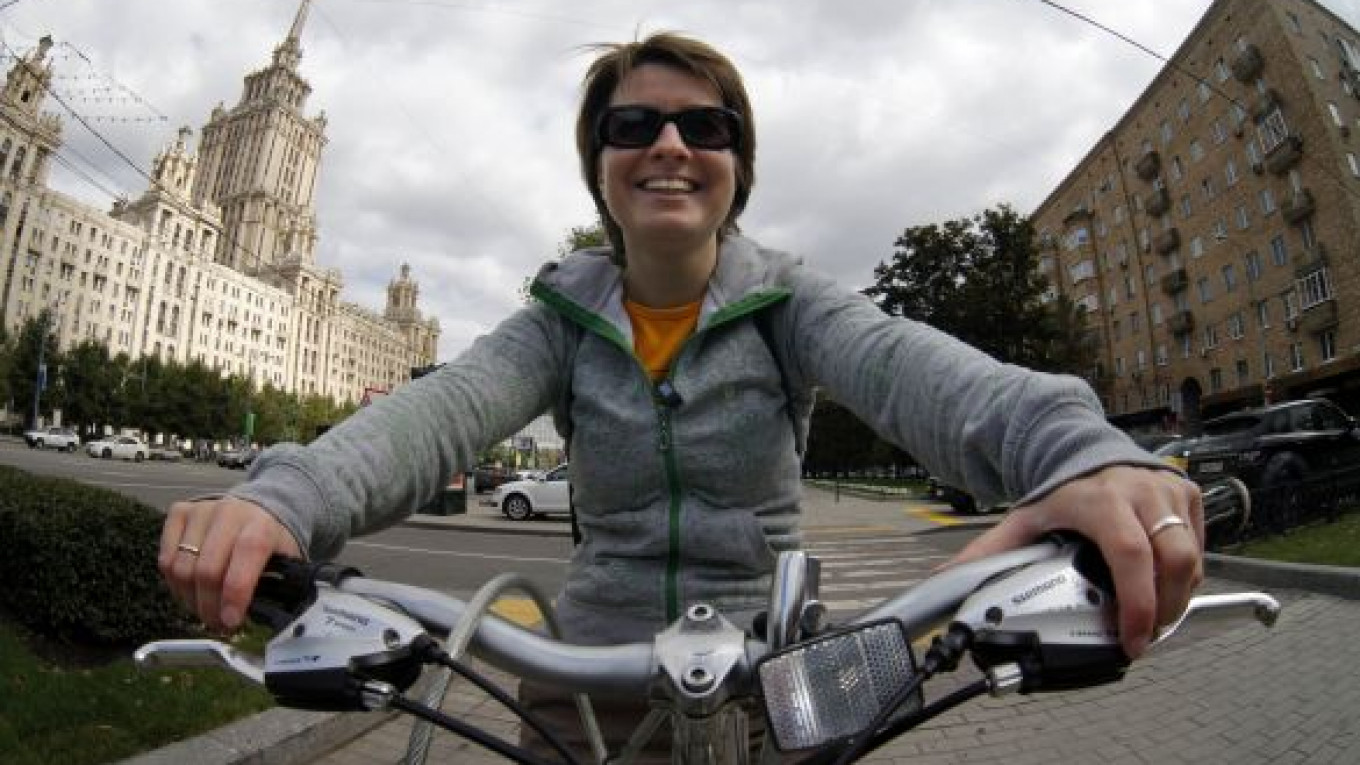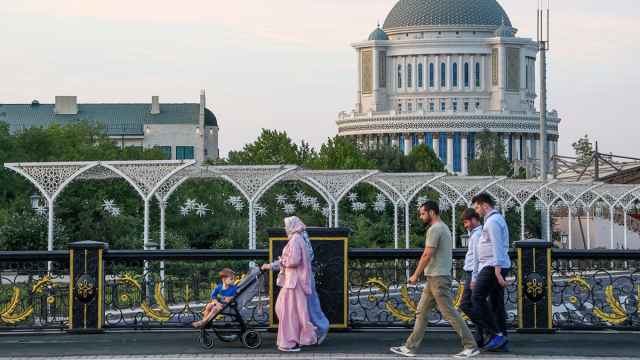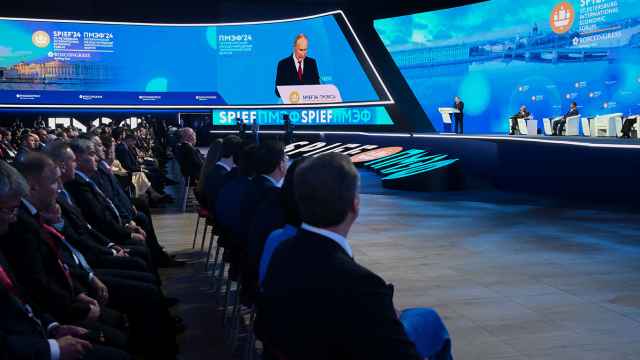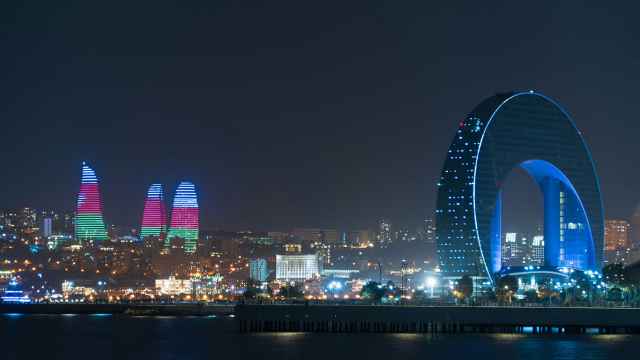One popular joke in Moscow goes: "When the drunken driver was taken to the police station he was already sober. Why? Traffic jams."
With congestion in the capital going from bad to infernal, an increasing number of people see cycling as a solution.
But riding a bike in Moscow is somehow a different experience from cycling in any other European city. With no bike lanes but plenty of road rage, most cyclists in Moscow, myself included, keep off the streets and stay on the sidewalk. But while cycling on the pavement, you need to watch out not only for pedestrians and baby carriages but for the sudden opening of car doors. Yes, parking on the sidewalk is also OK in the Russian capital.
Traffic jams have become as recognizable a feature of Moscow as the Kremlin's onion domes. Congestion is so bad that it's common to spend three hours traveling from downtown to the outskirts during rush hour. Motorists are estimated to spend an average of 15 hours a week stalled in traffic.
So in a truly revolutionary step to make Moscow bike-friendly and ease congestion, the city government has earmarked more than 600 million rubles ($20 million) over the next four years to build cycling paths and bike racks.
I started cycling to work in the summer of 2010 when a colleague, who lives much farther from the office than I do, mentioned that he occasionally cycles to work. Just five years ago the only people who rode bikes in Moscow were either teenagers or eccentric elderly men. Now it's not unusual to see an investment banker cycle to work.
I try to cycle to work a couple of times a week in warm weather, which is May through early October here. Despite the lack of bike lanes and the hostility of motorists and pedestrians alike, cycling in Moscow can be a joy compared to the headaches of driving: You fly past the gridlock and don't have to worry about finding a parking spot.
For Vladimir Kumov, founder of Let's Bike It!, a group that promotes cycling in Moscow, the awakening came two years ago when he spent three hours in traffic driving in from the airport after a three-month trip to Argentina, where he cycled all over town between his job and Spanish classes.
"People are tired of wasting their time in traffic, tired of seeing this city clogged with cars, and they are starting to realize that we can change the way we live now," he said.
My cycling day starts with carrying my bike down three flights to the street. One of the issues that Moscow cyclists face is a near complete absence of bike racks. Because there are none in my neighborhood — and I had a bike stolen once even from inside my apartment building — I keep my bicycle on my balcony. Carrying the bike up and down the steps is probably the most physically challenging part of my journey. Like most Soviet-era apartment buildings, mine is not equipped to meet the needs of cyclists, wheelchair users or parents with prams.
There's only one cycling path in this city of 12 million and no bike lanes on the roads whatsoever. Traffic rules in Russia provide for cycling on the road, although cyclists are not welcome there. Nor are they appreciated by pedestrians. For me the choice comes down to this: Either risk breaking your neck on the road, where motorists are aggressive and routinely run red lights, or cycle on the sidewalk, even if that means getting nasty looks and having to dismount often to maneuver through crowds.
An overwhelming majority of cyclists in Moscow prefer not to test their luck on the dangerous roads.
My 10-kilometer route takes me through some of the city's greenest and most picturesque areas — leafy Sparrow Hills and the park near Moscow State University. But some parts of my route are unpleasant in a bizarre way. I still can't grasp why a pole with a road sign had to be placed right in the middle of a sidewalk, on a cement slap so large that I have to squeeze through every time I ride by.
And there are other small inconveniences, like steep and uneven curbs, which also have me hopping on and off my bike — and are a nightmare for the handicapped. The city has made some progress in recent years in making the sidewalks more wheelchair-friendly. Even so, it is not uncommon for an embankment to end suddenly with a flight of stairs.
The AP Moscow bureau is inside a sprawling compound that houses the offices of scores of foreign media organizations as well as apartments for journalists and diplomats. Still, there's only one bike rack for the entire compound, so I normally leave my bike chained to a railing, which is more or less safe because of video surveillance.
The Kremlin, apparently, is no better equipped.
When Masha Gessen, a prominent journalist, had a meeting with President Vladimir Putin in September, his staff told her there was nowhere to park her bike inside the Kremlin, so she had to leave it chained up at a bus stop nearby.
Desperate to do something to ease Moscow's traffic congestion, city authorities hope that cycling can be part of the solution. Muscovites own about 3 million bikes, but few use them as a means of transportation, according to a recent report.
In the next four years, the city plans to increase the number of bike paths to 72 and the number of bike racks to 17,000.
The city expects the bike paths to help increase the average speed of cycling to 15.5 kilometers per hour and the share of those cycling to work from 0.01 percent to 1.2 percent by next year. For the city of 12 million, that would be 144,000 people.
While supportive of the city plans, cycling activist Kumov remains skeptical, largely because many of the paths are going to be built in parks, thus chiefly to promote cycling as recreation and not as a means of transport.
"The way the plan looks now will probably make little difference," he said.
Related articles:
A Message from The Moscow Times:
Dear readers,
We are facing unprecedented challenges. Russia's Prosecutor General's Office has designated The Moscow Times as an "undesirable" organization, criminalizing our work and putting our staff at risk of prosecution. This follows our earlier unjust labeling as a "foreign agent."
These actions are direct attempts to silence independent journalism in Russia. The authorities claim our work "discredits the decisions of the Russian leadership." We see things differently: we strive to provide accurate, unbiased reporting on Russia.
We, the journalists of The Moscow Times, refuse to be silenced. But to continue our work, we need your help.
Your support, no matter how small, makes a world of difference. If you can, please support us monthly starting from just $2. It's quick to set up, and every contribution makes a significant impact.
By supporting The Moscow Times, you're defending open, independent journalism in the face of repression. Thank you for standing with us.
Remind me later.






